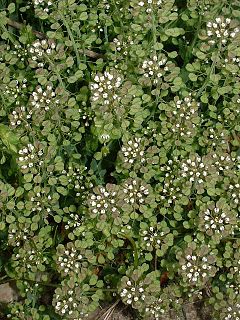
Lycium is a genus of flowering plants in the nightshade family, Solanaceae. The genus has a disjunct distribution around the globe, with species occurring on most continents in temperate and subtropical regions. South America has the most species, followed by North America and southern Africa. There are several scattered across Europe and Asia, and one is native to Australia. Common English names for plants of this genus include box-thorn and desert-thorn.

Lycium barbarum is a shrub native to China, with present-day range across Asia and southeast Europe. It is one of two species of boxthorn in the family Solanaceae from which the goji berry or wolfberry is harvested, the other being Lycium chinense.
Lozotaenia capensana, the Cape roller or apple leafroller, is a species of moth of the family Tortricidae. It is found in Gambia, Malawi, Mozambique, Zimbabwe, South Africa and on Saint Helena in the South Atlantic.

Lycium australe, the Australian boxthorn, is a native Australian plant with large sharp woody spines, small leaves and very small berries. It is closely related to Lycium ferocissimum, which is listed as an invasive weed in Australia, New Zealand and Cyprus.
Carlina involucrata is a species of perennial herb in the family Asteraceae. They have a self-supporting growth form and broad leaves.
Hypericum australe is a species of plants in the family Hypericaceae. Individuals can grow to 24 cm tall.

Lycium intricatum is a species of plants in the family Solanaceae (nightshades).

Matricaria aurea is a species of plants in the family Asteraceae.

Melilotus segetalis is a species of plants in the family Fabaceae.

Micromeria graeca is a plant species in the family Lamiaceae.
Micromeria microphylla is a species of plants in the family Lamiaceae.
Valerianella eriocarpa is a plant species in the family Caprifoliaceae.

Orobanche caryophyllacea is a plant species in the family Orobanchaceae.

Parietaria lusitanica is a species of plants in the family Urticaceae.
Persicaria lanigera is a species of plants in the family Polygonaceae.
Plantago crypsoides is a species of annual herb in the family Plantaginaceae. They have a self-supporting growth form and simple, broad leaves.

Plantago serraria is a species of plants in the family Plantaginaceae.
Ruppia drepanensis is a species of plants in the family Ruppiaceae.

Tamarix africana is a species of tree in the family Tamaricaceae. They have a self-supporting growth form and simple leaves. Individuals can grow to 6.3 m.

Thlaspi perfoliatum is a species of plants in the family Brassicaceae.











